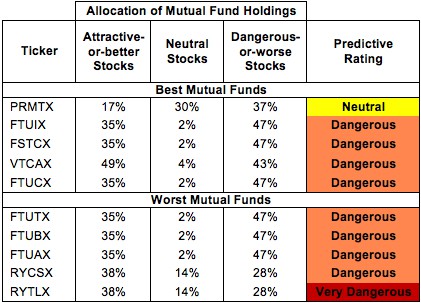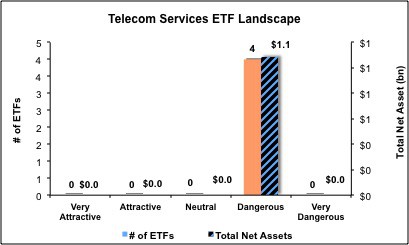The Telecom sector ranks seventh out of the ten sectors as detailed in my Sector Rankings for ETFs and Mutual Funds report. It gets my Dangerous rating, which is based on aggregation of ratings of four ETFs and 12 mutual funds in the Telecom sector as of April 19, 2013. Prior reports on the best & worst ETFs and mutual funds in every sector and style are here.
Figure 1 ranks from best to worst the four Telecom Services ETFs and Figure 2 shows the five best and worst-rated Telecom Services mutual funds. Not all Telecom sector ETFs and mutual funds are created the same. The number of holdings varies widely (from 23 to 51), which creates drastically different investment implications and ratings. The best ETFs and mutual funds allocate more value to Attractive-or-better-rated stocks than the worst ETFs and mutual funds, which allocate too much value to Neutral-or-worse-rated stocks.
To identify the best and avoid the worst ETFs and mutual funds within the Telecom sector, investors need a predictive rating based on (1) stocks ratings of the holdings and (2) the all-in expenses of each ETF and mutual fund. Investors need not rely on backward-looking ratings.
My fund rating methodology is detailed here.
Investors should not buy any Telecom ETFs or mutual funds because none get an Attractive-or-better rating. If you must have exposure to this sector, you should buy a basket of Attractive-or-better rated stocks and avoid paying undeserved fund fees.
Active management has a long history of not paying off. And this sector appears to be one where investors will not get what they pay for if the trust their money to a mutual fund manager or ETF provider.
Get my ratings on all ETFs and mutual funds in this sector on my free mutual fund and ETF screener.
Figure 1: ETFs with the Best & Worst Ratings – Top 5
* Best ETFs exclude ETFs with TNAs less than $100 million for inadequate liquidity.
Sources: New Constructs, LLC and company filings
Figure 2: Mutual Funds with the Best & Worst Ratings – Top 5
* Best mutual funds exclude funds with TNAs less than $100 million for inadequate liquidity.
Sources: New Constructs, LLC and company filings
Vanguard Telecom ETF (VOX) is my top-rated Telecom ETF and T Rowe Price Media & Telecommunications Fund, Inc. (PRMTX) is my top-rated Telecom mutual fund. VOX earns my Dangerous rating and PRMTX earns my Neutral rating.
ProShares Ultra Telecommunications ProShares (LTL) is my worst-rated Telecom ETF and Rydex Series Funds: Telecommunications Fund (RYTLX) is my worst-rated Telecom mutual fund. LTL earns my Dangerous rating and RYTLX earns my Very Dangerous rating.
Figure 3 shows that 38 out of the 91 stocks (over 53% of the market value) in Telecom ETFs and mutual funds get a Neutral-or-better rating. It is troubling then that only one mutual fund and no ETFs manage to earn a Neutral rating.
The takeaways are: mutual fund managers allocate too much capital to low-quality stocks and Telecom ETFs hold poor quality stocks. For some reason, they are choosing the bad stocks instead of the good one. Investors should beware.
Figure 3: Telecom Sector Landscape For ETFs, Mutual Funds & Stocks
As detailed in “Cheap Funds Dupe Investors”, the fund industry offers many cheap funds but very few funds with high-quality stocks, or with what I call good portfolio management.
Investors should tread carefully when considering Telecom ETFs and mutual funds, as four ETFs and 11 mutual funds in the Telecom sector earn a Dangerous-or-worse rating. No Telecom ETFs or mutual funds allocate enough value to Attractive-or-better rated stocks to earn an attractive rating. Investors seeking exposure to this sector should focus on individual stocks instead.
Vonage Holdings (VG) is one of my favorite stocks held by Telecom ETFs and mutual funds and earns my Attractive rating. I love companies like Vonage because they leverage technology to provide services more efficiently. Not only does Vonage lower the costs of communication for consumers, they do so in a profitable and efficient manner by avoiding the capital intensity of the legacy networks. Vonage’s return on invested capital is the best in the Telecom sector by a wide margin. At 91%, VG’s ROIC is amongst the elite value-creating companies. They have been able to achieve this impressive figure by managing their working capital to maximize cash flows. The company has generated positive free cash flow every year since 2007. In 2012, the company’s economic earnings were higher than its GAAP earnings, a rare achievement.
Given that few investors monitor economic earnings, the stock is available at a bargain. The current valuation (~$3/share) implies that Vonage’s NOPAT will only grow 15% from 2012’s fiscal year value over the rest of its corporate life. Those low expectations make a profitable company like Vonage an attractive buy.
CenturyLink Inc. (CTL) is one of my least favorite stocks held by Telecom ETFs and mutual funds and earns my Dangerous rating. CTL has significant liabilities on its balance sheet and hidden in its voluminous footnotes. Total debt (including $1.5 billion off balance sheet debt), underfunded pensions, and deferred tax liabilities of CTL add up to over $32 billion, more than 140% the stock’s market capitalization. In addition, CTL’s return on invested capital (ROIC) fell to only 3% last year, its lowest level in well over a decade. CTL will be hard pressed to dig itself out of the hole it’s in if it cannot get better returns on its capital. Despite all these negatives, CTL has ambitious expectations embedded in its market price. To justify its current valuation of ~$36.85, CTL would have to grow NOPAT by 7% compounded annually for 17 years. Betting on that kind of growth for any company is risky, especially if the company’s ROIC is declining.
41 stocks of the 3000+ I cover are classified as Telecom stocks, but due to style drift, Telecom ETFs and mutual funds hold 91 stocks.
Figures 4 and 5 show the rating landscape of all Telecom ETFs and mutual funds.
My Sector Rankings for ETFs and Mutual Funds report ranks all sectors and highlights those that offer the best investments.
Figure 4: Separating the Best ETFs From the Worst ETFs
Figure 5: Separating the Best Mutual Funds From the Worst Mutual Funds
Review my full list of ratings and rankings along with reports on all four ETFs and 12 mutual funds in the Telecom sector.
Sam McBride contributed to this report.
Disclosure: David Trainer owns Vonage (VG). David Trainer and Sam McBride receive no compensation to write about any specific stock, sector or theme.





